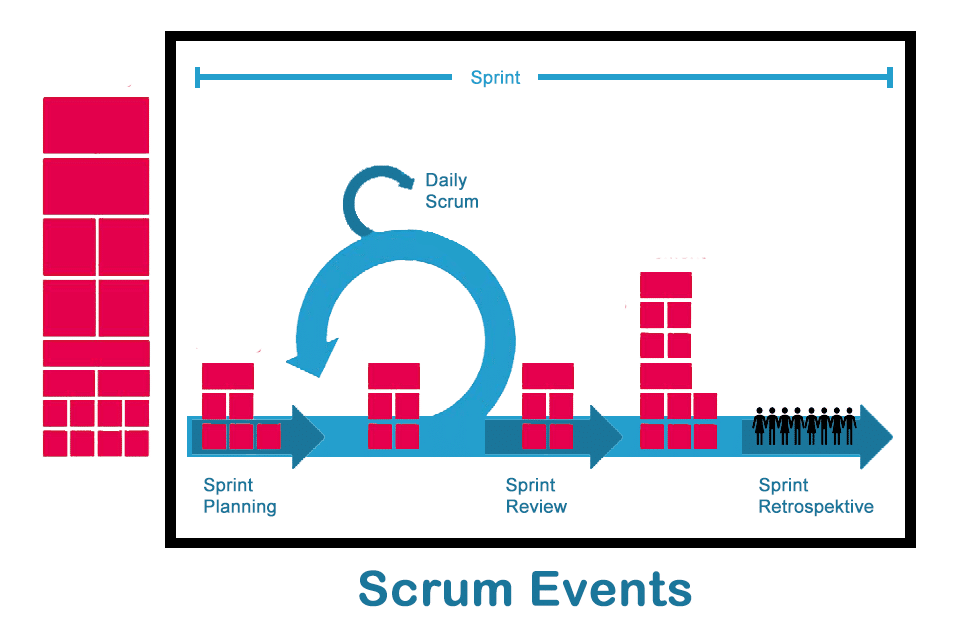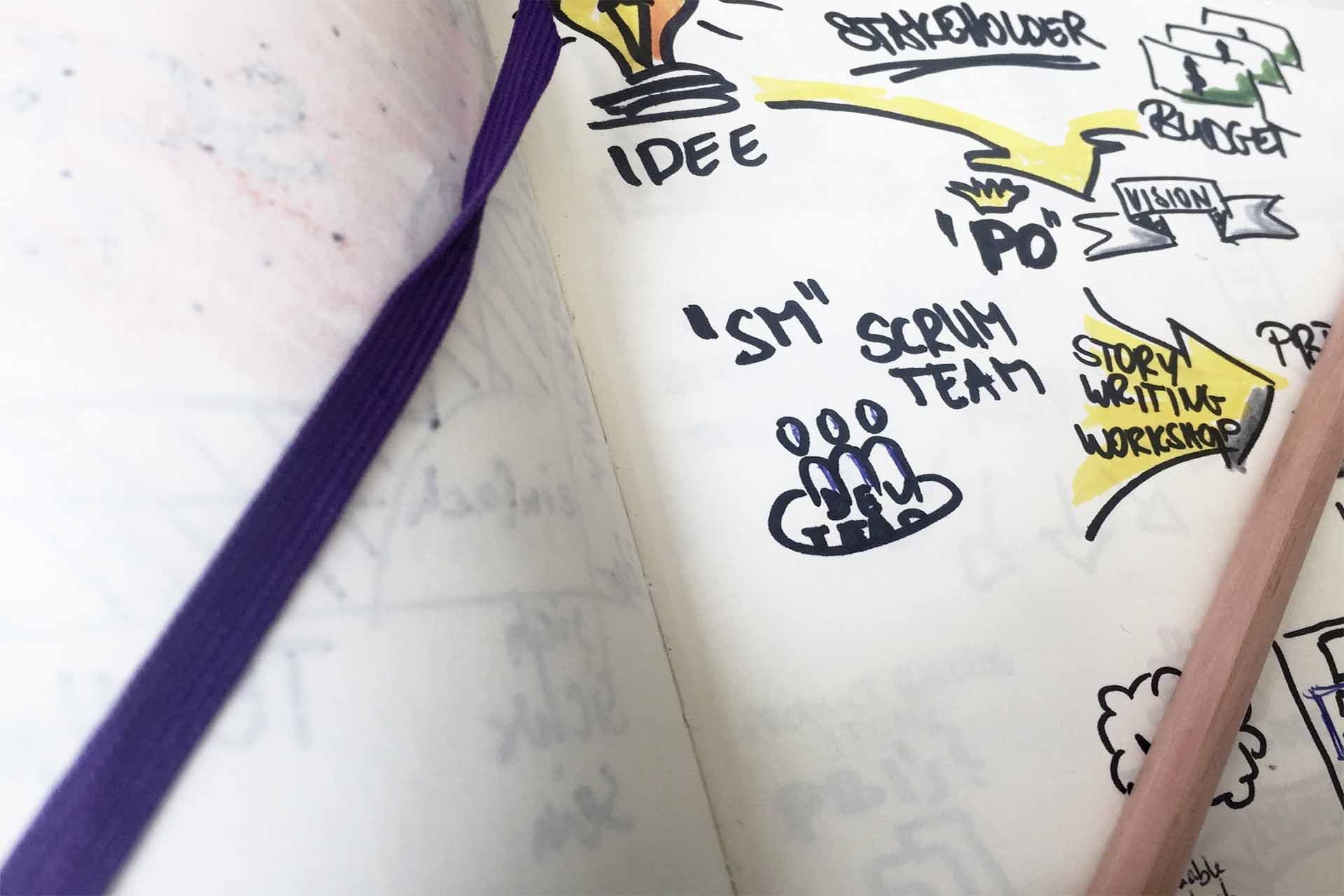What are Scrum Events?
Smartpedia: Five Scrum Events (Sprint, Sprint Planning, Daily Scrum, Sprint Review and Retrospective) are defined in the Scrum Guide. The Sprint is considered the centrepiece.
Scrum Events – with transparency, communication and feedback to the goal
Scrum addresses the collaborative development of complex products and services. The Scrum Guide defines five so-called events for this collaborative development: the Sprint, the Sprint Planning, the Daily Scrum, the Sprint Review and the Sprint Retrospective.
The events are designed to
- increase the transparency of the work steps and interim results of the participants,
- promote communication between the participating employees,
- enable short feedback loops,
- identify and correct deviations.
Scrum Events are used to create regularity and minimise the need for meetings, which are not defined in Scrum. They also provide a formal opportunity to review and adjust artefacts. Optimally, all events are held at the same time and place to reduce complexity.¹
Sprint – the heart of Scrum
A leitmotif of the framework is the development of products in short cycles or increments. These short cycles are called Sprints. They are the heart of Scrum. It is important that Sprints have a consistent duration throughout the development process. When working with parallel teams, organisations should ensure that Sprints run synchronously so that there are no unnecessary waiting times between teams.
Despite all openness to new things, it is important to avoid changes within a Sprint that jeopardise the agreed Sprint Goal. This is a premise that must be achieved together so that a functional increment is created and could potentially be made available to customers. If individual backlog items are not implemented, the Sprint is not extended, but the corresponding items are scheduled for one of the next Sprints if necessary. The adjustment of quality goals and acceptance criteria is not planned, but if the Sprint Goal becomes obsolete, the Product Owner can also cancel a Sprint.
Sprint Planning – why, what and how
At the beginning of a Sprint, the Sprint Planning takes place. It is a gathering to plan the requirements and work packages that are to be implemented in the current Sprint. Participation is mandatory for the developers. The Scrum Event is organised by the Product Owner and moderated by the Scrum Master.
Sprint Planning is divided into two phases:
- In Sprint Planning 1, the “why” and “what” are discussed, i.e. why is the sprint valuable and what should be realised. A Sprint Goal is agreed upon and the developers commit to implementing the agreed requirements in the next Sprint.
- In Sprint Planning 2, the developers agree on the “how”, i.e. how the team will realise the requirements. To do this, they define tasks and often visualise them with a task board. At the end of Phase 2, the developers should be able to explain to the Product Owner and the Scrum Master how they will work as a self-managing team to achieve the Sprint Goal and create the expected increment.
Daily Scrum – the daily Scrum Event
The Daily Scrum is a daily standup meeting where the developers meet to synchronise each other and exchange information about progress, upcoming activities and possible problems. Participation in the Scrum Event is mandatory for the developers; in addition, the Scrum Master and possibly the Product Owner should attend. In practice, it has proven useful for each team member to answer three questions – always with reference to the Sprint Goal:
- What have I done since yesterday to help the team achieve the Sprint Goal?
- What will I do by tomorrow to help the team reach the Sprint Goal?
- What is preventing me or the team from reaching the Sprint Goal?
By sharing, redundancies are avoided.
Sprint Review – the exchange about progress
The Sprint Review is an event at the end of a Sprint to inspect the completed work in relation to the set Sprint Goal and to discuss future adjustments. The Sprint Review is attended by the Scrum Team and all involved employees. Selected stakeholders – persons or groups with an interest in the Sprint results – e.g. users, managers, representatives from areas such as marketing, sales or IT can also take part.
The Sprint Review shows what was worked on in the Sprint and which backlog items were implemented. Since only realised items and their implementation are presented live in the product, the progress of the development is directly visible to all participants. Through the participation of stakeholders, they can express direct feedback and thus criticism, praise and suggestions for improvement, which may be considered by the Product Owner for the next Sprint.
Sprint Retrospective – improving the cooperation in the team
A Retrospective is a regular meeting where the Scrum team meets to review the recent past – i.e. the past Sprint – in order to improve the future cooperation in the team. It is the Scrum Event where
- processes,
- tools,
- skills,
- relationships,
- challenges and
- experiences
are reflected upon. The feedback offers opportunities both for the team as a whole and for each individual participant.
The goals are to improve cooperation in the team and thus to improve processes and content, as well as to define measures, dos and don’ts, based on the jointly gained insights. In addition, the Retrospective offers space for open feedback in the team and for reviewing the agreed measures of the past Retrospective. In practice, there are a large number of ways to hold Retrospectives and it is advisable to adjust the procedure every now and then in order to keep the interest in the exchange among each other high.
Alternative names for Scrum Events
There are a number of alternative names for Scrum Events:
- meetings,
- rituals,
- activities or
- ceremonies.
The term Scrum Meeting is probably used relatively often, since the various formats always involve a meeting in one place. In Daily Scrum, for example, the Scrum team gathers around the task board, in Sprint Planning, for example, the team jointly uses a user story map etc.
Some publications discuss whether there is a difference between an event and a ceremony. An event is a “special occurrence” and a ceremony is a “ceremonial act that takes place in certain fixed forms or according to a rite”. Now, on the one hand, it is argued that ceremonies rather stand for a “mechanical” Scrum and consequently the companies do not think about better ways on the way to better results. On the other hand, it can of course also be stated that something recurring like Scrum Events lose the “specialness” of an event after a certain while at the latest.
Since the Scrum Guide also speaks of events in its German translation, you should be on the safe side with this term in possible discussions.
Impulse to discuss:
Do you think that one Scrum Event is more important than the others or are they all equally important?
Notes:
[1] See information about the Scrum Guide and the original documentation respectively.
By the way, the Backlog Refinement is also an activity that takes place regularly. However, it is not officially declared as a Scrum Event.
If you like the article or would like to discuss it, please feel free to share it in your network. And if you have any comments, please do not hesitate to send us a message.
And here you will find additional information from the t2informatik Blog:




